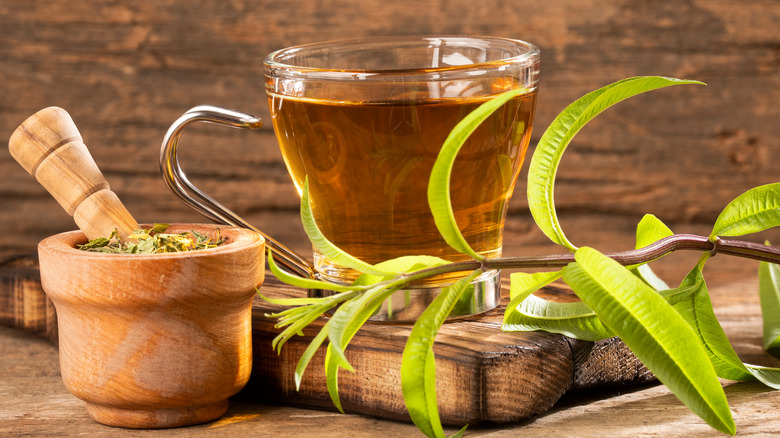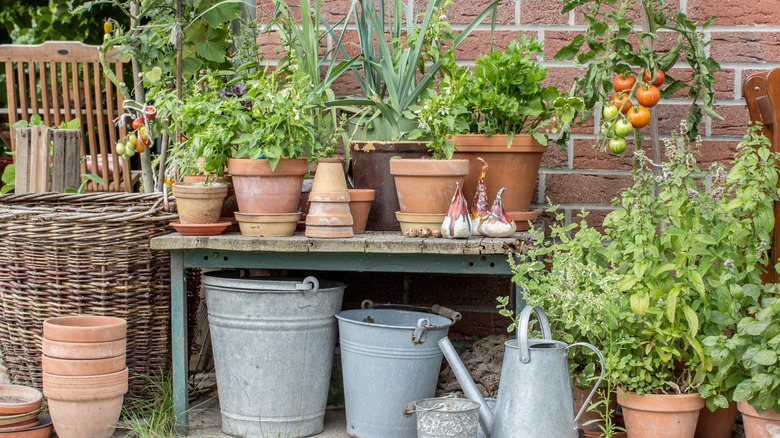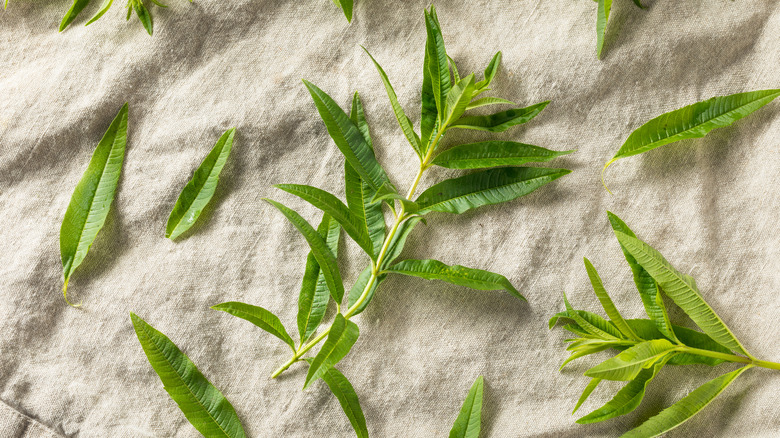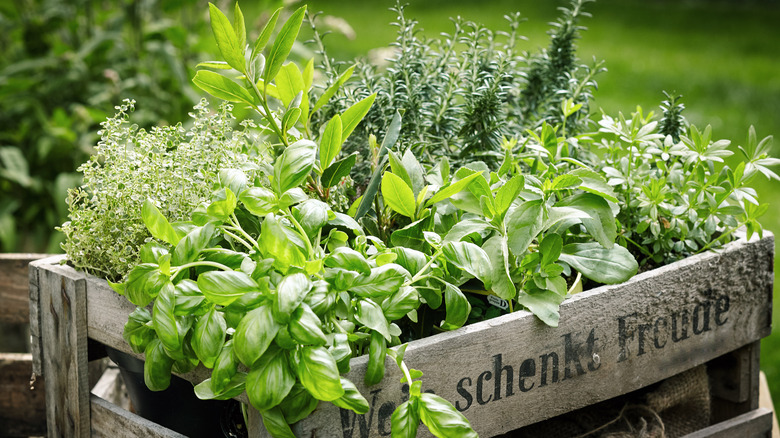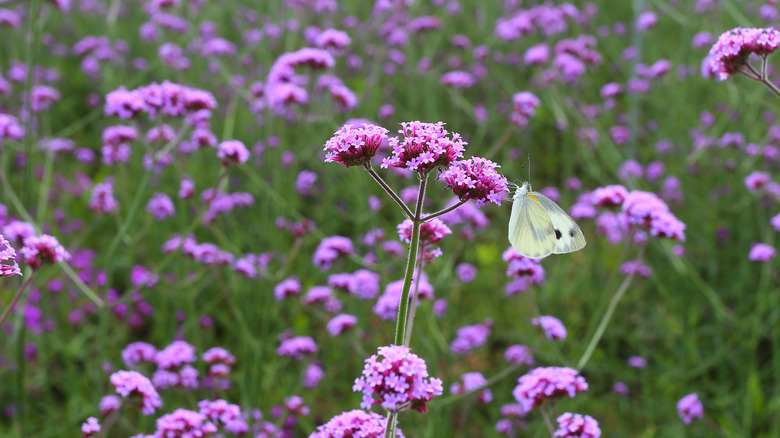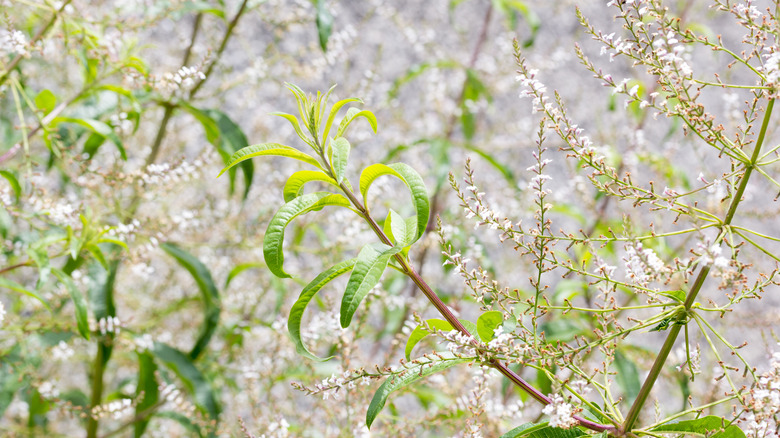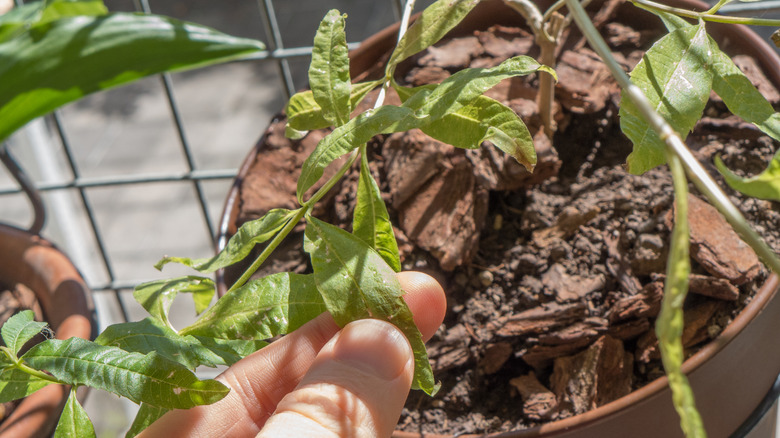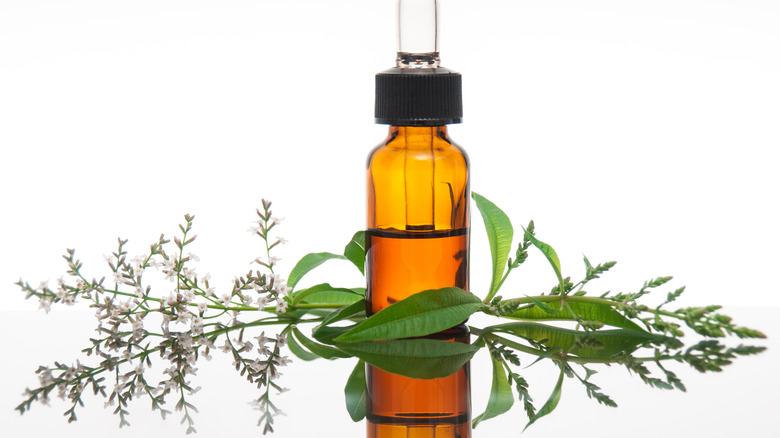How To Grow And Care For Lemon Verbena
Aloysia citriodora is the botanical classification name for lemon verbena, which is occasionally referred to as lemon beebrush. Its native roots are South American, specifically from Argentina, Bolivia, and Paraguay, and it made its way to Europe in the 1600s via the ships of Spanish explorers. It wasn't until 1784 that it was first described by a botanist named Antonio Palau. Mature lemon verbena plants will produce rather insignificant flowers, but this is not a plant you generally cultivate for looks. Instead, this is a hardworking medicinal, aromatherapy, and culinary herb. As you may have guessed, this common kitchen companion has a lemony-citrusy scent. According to the North Carolina State Extension Gardener Plant Toolbox, this is why the word citriodora is used in its botanical classification name.
Much to our chagrin, lemon verbena is included in the Invasive Species Compendium due to its penchant for naturalizing itself to any and every possible environment. This means it does not rely upon humans for cultivation. It spread its own seeds far and wide, thank you very much, and it can propagate itself into a healthy new plant from a tiny piece of stem left sitting around in the sun. While it's considered nothing more than a weed in some regions of the world, most people are pleased with its presence. We like it for its fragrance and flavor. We think its little white flowers are kind of pretty, too. And many of us depend on it for its substantial medicinal and aromatherapeutic properties.
How to use lemon verbena in a garden
When you're mapping out your garden space, think of lemon verbena as an herb rather than a flowering plant or vegetable. After the final frost has passed, it can be planted into the ground, although a raised bed may be a safer option, and it will do just as well as part of a container garden. Full sun exposure is essential for lemon verbena health so find it a spot that will never be riddled with shade. With herbs, in particular, you can often plant a few different types in the same container provided they all require similar growing conditions. Lemon verbena will be one of your larger sun-loving herbs. As such, gardening experts at Plantura Magazine list St. John 's wort, coriander, lemon balm, and licorice as good companion plants.
Left to their own devices in the ground, lemon verbena shrubs can expand upwards and outwards into a 6- to 8-foot bush. Regular pruning will not only maintain your plant at a reasonable size for an herb garden or container, but it will also give you all the leaves you could ever desire for use in cooking and fragrance making. Per Overdevest Nurseries via YouTube, there's almost nothing in the world that smells as pleasant as lemon verbena. For this reason, plant it somewhere close to foot traffic so you can touch the leaves and reap their olfactory rewards on a regular basis.
How to grow lemon verbena
Aloysia citriodora plants can be grown from seed but unless you have to do so, you might want to stick to propagating by other methods instead. Plantura Magazine notes that germination can take quite a few weeks to occur and it is far from guaranteed. Starting with quality seedlings purchased at a trusted nursery or taking cuttings from an already established plant is a better way to go.
To propagate by cutting, you'll be working with new growth, so aim to start your project in the spring or early summer. Make your cut about 6 inches down from the tip of a stem. The piece you remove should be flexible, green, and new growth. If possible, try to cut right where the stem turns to wood. Best practices call for clean and sterilized garden tools to help prevent the spread of disease. Use them to make the initial cut and also to remove all of the leaves except the top few. Consider dipping the cut end of the stem in rooting hormone powder to speed up root development before planting it in the soil. Another tip for creating a more humid and productive growth environment for your soon-to-be-seedling is to cover your planted cutting in plastic.
Now make yourself a cup of lemon verbena tea with all those leaves you removed. Sit back, put your feet up, and relax while you patiently wait about three weeks for roots to appear.
How to care for lemon verbena
No soggy roots for this little plant! Drainage and proper watering are key factors in lemon verbena care, according to Epic Gardening, as are higher temperatures. If you've planted yours in the garden, be prepared to transplant it into a container you can bring inside for overwintering or risk losing the plant at the end of the season. Unless you live in a USDA hardiness zone of 8 or above, it won't be able to survive the cold months.
Regularly watering your plants will stop the leaves from dropping and help keep away pests. A moisture meter is a very helpful tool that allows you to monitor water retention beneath the surface of the soil. Epic Gardening further suggests regularly adding liquid fertilizer that is high in nitrogen, and tending to your plants through pruning. It'll seem like overkill the first time you do it, but these plants can be cut back to two-thirds of their original size on a yearly basis. Do this before they enter their growing season in early spring.
Verbena varieties
There is only one lemon verbena; however, according to the North Carolina State Extension Gardener Plant Toolbox, the species that we now know as Aloysia citriodora has gone through many name changes over the years. Aloysia triphylla, Lippia citriodora, Verbena citriodora, and Verbena triphylla are just a few of the botanical classifications that have been assigned to lemon verbena. It's unclear why there have been so many previous names, but rest assured that if you find information on any of those species, they are all referring to the same plant.
The Plant List is a professional database that is busy compiling every single known species of flowering plant as well as others like conifers, ferns, and mosses. So far they've collected more than a million entries, all of which need to be confirmed or accepted. Within the broader Verbena genus, they have registered well over 500 possible species, 124 of which have been confirmed. The most recognized and commonly found is certainly Verbena bonariensis, or purpletop vervain (pictured above). It's that easy-to-grow, ultra-happy purple flower found attracting butterflies to gardens just about everywhere.
Is lemon verbena toxic?
Per the American Society for the Prevention of Cruelty to Animals, the essential oil of lemon verbena is considered toxic to cats, dogs, and horses. It's always best to keep your indoor and container plants away from pets and, as much as possible, keep your pets out of the garden. But in this instance, it's more important to keep them away from any bottled essential oil. You can expect to see gastrointestinal distress as well as general fussiness in animals who have consumed this plant or its oil.
That same essential oil has a much lower poison severity for humans. It is often used as a medicinal herb with mild stomach upset as the strongest expected side effect. When used in appropriate doses, it is considered safe for human consumption. It is also deemed safe when brewed as a tea, used to flavor alcohol, or added to cooking as an herb, whether dried or fresh.
Medicinally speaking, in a placebo-controlled study, lemon verbena has been scientifically proven to aid insomniacs in finally getting some much-needed rest. Healthline confirms that it is also used as a supplement for its anti-inflammatory and anti-obesity properties. It helps maintain healthy cells and makes an excellent addition to your self-care routine, even if you're only using it for its invigorating yet calming scent.
How to repot lemon verbena
A young lemon verbena plant can grow a lot in its first year. If you've kept it going through the winter, either by overwintering indoors or keeping it outside in a warm enough temperature zone, it will most likely be ready for a repotting come spring. On his YouTube channel, Tom Digs This shows how easy it can be to freshen up a root-bound or simply tired plant without even needing a new container. In a few quick and easy steps he removes the entire plant from the pot and shakes loose the old, dried-out soil. He then refills the pot with fresh nutrient-dense compost mixed with perlite for added drainage. The plant goes back into the pot and is covered with more compost, after which it is gently yet thoroughly watered.
That may be all this plant needs to keep thriving. Provided that the last frost has come and gone, it'll be time to get your lemon verbena back outside to bask in direct sunlight where it can come fully out of its winter dormancy and experience a growth spurt as you move toward summer.
Lemon verbena essential oil
Essential oils are the go-to therapeutic modality in spas and retreat centers everywhere. Some concoctions are meant to calm the nerves and others are touted to relieve joint pain and other ailments. Because of its zesty, uplifting citrus scent, lemon verbena essential oil can be found in everything from scented candles to massage oils, essential oil diffusers, and potpourri. Per Sweet Grass Farm, when rubbed into the skin, a combination of citral, geraniol, and other antioxidant compounds make it a strong contender against free radicals that cause cell damage. As a result, less oxidative stress means improved immune system function.
Lemon verbena essential oil is also used in soaps and moisturizers. Recipes with Essential Oils recommends mixing it with water and witch hazel in a spritzer bottle to create an aromatherapy room spray. For an exceptionally pleasant fragrance combination, blend it with mint and other citrus-scented oils.
Please note that essential oils should never be consumed for internal use. They are not the same as supplements and should only be used aromatically or topically.
